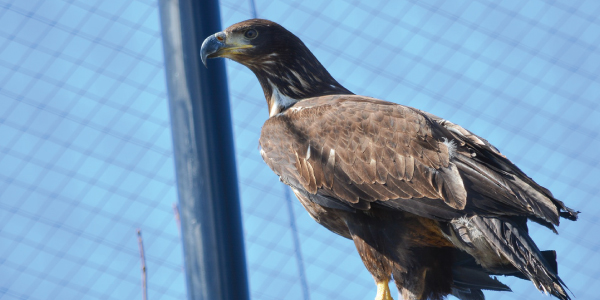
| You can meet at the Racine Zoo: |
America
|
| Location at the Racine Zoo: | Raptor's Roost |
| Scientific Name: | Haliaeetus leucocephalus |
| Conservation Status: | Least Concern |
| Lifespan: | 20 – 30 years in the wild; up to 50 years in human care |
| Adult Size: | 2.5 – 3 ft tall; up to 14 lb in weight; wingspan of 6 – 8 ft |
| Diet in the wild: | Small mammals, waterfowl, and fish |
| Diet in the Zoo: | Rodents, small birds |
| Habitat: | Lakes and reservoirs with surrounding forests |
| Range: | Throughout the U.S., most of Canada, and northern Mexico |
| Threats: | Threats in the wild include illegal shooting, lead poisoning, habitat loss, powerlines and wind turbines |
Fun Facts:
- Bald eagles build the largest nest of any North American bird.
- Bald eagles are the national bird of the United States and appear on its seal.
- Bald eagles can fly as high as 10,000 feet, and are very maneuverable while flying, despire being morphologically less adapted for faster flight.
- The grip of a bald eagle talon is 10x stronger than that of humans.
- Bald eagles are not actually bald. Their heads are covered in white feathers. The name comes from an older meaning of the word "white-headed".
- Eagle eyes are the same size as a human's. Their vision is so precise, they can spot prey up to 2 miles away.
- Bald eagles return to the area they were born when they reach reproductive maturity and mate for life.
Conservation Messages:
- Bald eagles were previously endangered and nearly became extinct in the 1960s. They made a remarkable recovery after the passing of the Endangered Species Act and the banning of DDT. Avoid using poison for pests such as rodents, as eagles can be secondarily affected when they eat poisoned mice and rats. Be aware that keeping eagle parts, such as feathers or talons, is illegal without a federal permit.











